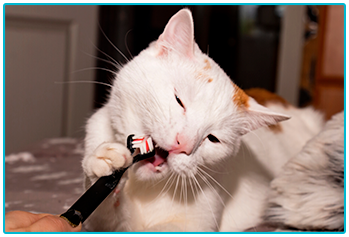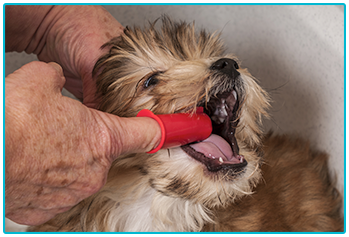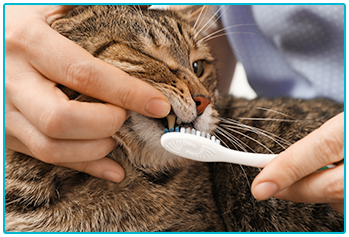Keeping teeth clean and healthy is important not just for us humans, but also for our pets! Without proper attention being paid to your dog or cat’s oral hygiene, they can be at risk from developing dental disease. We’ve spoken about dental disease in pets before, but thought that it was time to look in more detail at how to clean your pet’s teeth, as it can seem like a pretty daunting task! Read on to discover our tips.

What you’ll need
All you’ll need to keep your pet’s pearly whites spotless is a toothbrush and toothpaste, but make sure that both of these are pet-friendly. Pet toothbrushes are usually angled specifically to feel comfortable in a dog or cat’s mouth. You can even get finger brushes if your furry friend doesn’t take to a full brush. Human toothpaste can be harmful to pets, so make sure to get them dog- or cat-specific toothpastes, which often come in flavours like chicken or peanut butter!
Getting started
As with any new training, getting into the habit of brushing your pet’s teeth will be easier when they’re young! That being said, you can also get your older canine and feline companions used to good oral hygiene with a little patience. Don’t go in straight away with the toothbrush. Instead, gradually get them used to being touched around their mouth, teeth and gums with your finger. Reward them for putting up with this, but if they’re restless or show distress make sure to stop and come back to it another time.
Keep going

Once your pet has become accustomed to the feel of pressure on their teeth, gradually begin to introduce them to their toothpaste. Get them to lick a little from your finger. If they like it, you could put some on their toothbrush for them to interact with, as well as using your finger and some paste to give their teeth a mini clean. Remember to keep praising them and providing rewards!
Grab your brush
Finally, it might be toothbrush time! Once again, taking things slowly might be best in order to avoid causing distress to your pet. Get them to interact with the brush so they can check it out. Touch it to their face, lift their lips up and work the brush round until they grow accustomed to the process, giving them extra cuddles or treats along the way.
Tips and techniques
Just as when you brush your own teeth, using a circular motion when brushing your dog or cat’s teeth is best. Concentrate on the outside surfaces of their teeth, as they might not take too kindly to any pressure on the back of them. Spend around two to three minutes every day brushing their teeth in order to achieve the best results. One last tip: make sure not to brush too hard; the extra pressure might make your pet feel uncomfortable, and it could also damage the enamel!

If brushing doesn’t work
Not every single cat and dog will be happy having their teeth brushed. If you find training them to accept this is impossible, there are other ways to keep their teeth in good shape! There are many dental treats out there on the market that have been formulated to help reduce plaque, and more controversially, raw bones can be good for a dog’s teeth. There are also tooth wipes that could be a good alternative, as well as water additives and dental sprays that they probably won’t mind. Getting your pet’s teeth cleaned professionally at least once a year is also recommended*!
Hopefully we’ve given you enough pointers to help you keep your pet’s teeth bright! If you have any questions at all, it could be worth speaking to your vet. As a pet owner, you might also want to consider helping to protect your furry friend with pet insurance. At The Insurance Emporium, we offer a range of Cat Insurance and Dog Insurance products, with up to 30% discount^! Head over to The Insurance Emporium to find out more!
* The Insurance Emporium Pet Insurance does not cover costs as a result of tooth or gum disease.
^ The 30% discount is made up of 20% Introductory Discount plus 10% Multi-pet Discount (if appropriate). The Introductory Discount is available for the first 12 premium payments on lunar and calendar monthly policies or one premium payment on annual policies.
All content provided on this blog is for informational purposes only. We make no representations as to the accuracy or completeness of any information on this site or found by following any link on this site. We will not be liable for any errors or omissions in this information nor for the availability of this information. We will not be liable for any loss, injury or damage arising from the display or use of this information. This policy is subject to change at any time.


